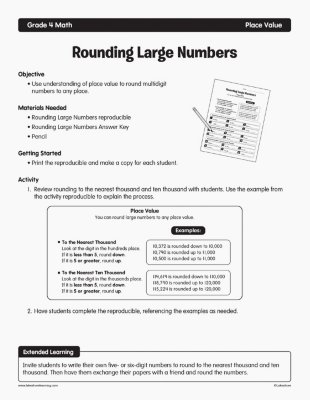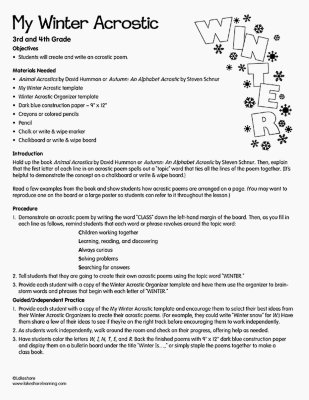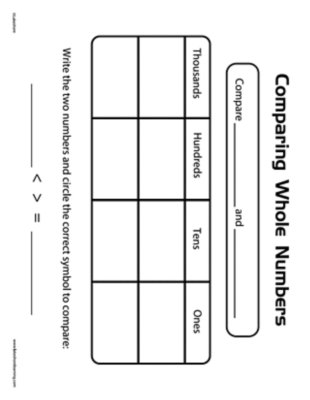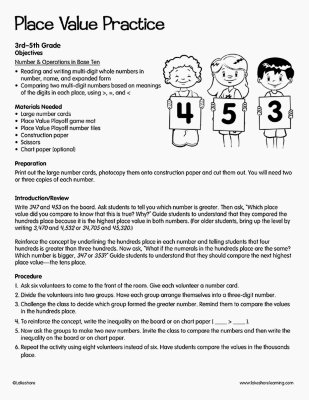Narrow by Grade
- Infant (0)
- Toddler (0)
- Preschool (0)
- Pre-K (0)
- Kindergarten (0)
- 1st (0)
- 2nd (0)
- 3rd (1)
- 4th (4)
- 5th (1)
- 6th & Up (0)
Grade
Narrow by Age
- 0-18m (3)
- 18-36m (2)
- 3 yrs. (0)
- 4 yrs. (2)
- 5 yrs. (4)
- 6 yrs. (1)
- 7 yrs. (2)
- 8 yrs. (3)
- 9 yrs. (4)
- 10 yrs. (1)
- 11 yrs. & Up (0)
Age 9 yrs.
4 results for "giant"
Filters
Clear All
Rounding Large Numbers
4th Grade
Objective
- Use understanding of place value to round multidigit numbers to any place.
My Winter Acrostic
3rd Grade - 5th Grade
Objectives Reading: Literature Reading and comprehending grade-appropriate literature, including stories, dramas, and poetry Writing Writing an acrostic poem Materials Needed Animal Acrostics by David Hummon or Autumn: An Alphabet Acrostic by Steven Schnur My Winter Acrostic template Winter Acrostic Organizer template Dark-blue construction paper - 9" x 12" Crayons or colored pencils Pencil Chalk or write & wipe marker Chalkboard or write & wipe board Introduction Hold up the book Animal Acrostics by David Hummon or Autumn: An Alphabet Acrostic by Steven Schnur. Then explain that the first letter of each line in an acrostic poem spells out a “topic” word that ties all the lines of the poem together. (It’s helpful to demonstrate the concept on a chalkboard or write & wipe board.) Read a few examples from the book and show students how acrostic poems are arranged on a page. (You may want to reproduce one on the board or a large poster so students can refer to it throughout the lesson.)
View Lesson PlanComparing Whole Numbers
4th Grade
Objective CCSS Math: Number & Operations in Base Ten 4.NBT.A.2: Read and write multi-digit whole numbers using base ten numerals, number names and expanded form. Compare two multi-digit numbers based on meanings of the digits in each place, using >, =, and < symbols to record the results of comparisons. Materials Needed Interactive whiteboard or chalkboard Large number cards Cardstock or Construction Paper - 9" x 12" (optional) Place value charts Preparation Make two sets of the number cards. (For durability, you may want to mount them onto sturdy construction paper or cardstock and laminate them.) Introduction Display the following symbols on an interactive whiteboard or chalkboard: > Invite students to discuss what each symbol means (greater than, less than and equal to). Remind students that these symbols are used when comparing two numbers to determine which is larger (greater than) or smaller (less than) or if they are equal.
View Lesson PlanPlace Value Practice
4th Grade
Objectives Number & Operations in Base Ten Reading and writing multi-digit whole numbers in number, name, and expanded form Comparing two multi-digit numbers based on meanings of the digits in each place, using >, =, and < Materials Needed Large number cards Place Value Playoff game mat Place Value Playoff number tiles Construction paper Scissors Chart paper (optional) Preparation: Print out the large number cards, photocopy them onto construction paper and cut them out. You will need two or three copies of each number. Introduction/Review Write 347 and 453 on the board. Ask students to tell you which number is greater. Then ask, “Which place value did you compare to know that this is true? Why?” Guide students to understand that they compared the hundreds place because it is the highest place value in both numbers. (For older students, bring up the level by writing 3,470 and 4,532 or 34,705 and 45,320.) Reinforce the concept by underlining the hundreds place in each number and telling students that four hundreds is greater than three hundreds. Now ask, “What if the numerals in the hundreds place are the same? Which number is bigger, 347 or 353?” Guide students to understand that they should compare the next highest place value—the tens place.
View Lesson Plan


